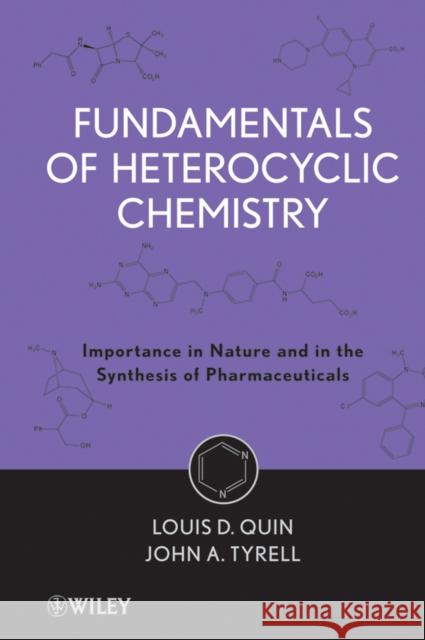Heterocyclic Compounds » książka



Heterocyclic Compounds
ISBN-13: 9780470566695 / Angielski / Twarda / 2010 / 344 str.
Heterocyclic Compounds
ISBN-13: 9780470566695 / Angielski / Twarda / 2010 / 344 str.
(netto: 420,30 VAT: 5%)
Najniższa cena z 30 dni: 436,80
ok. 30 dni roboczych.
Darmowa dostawa!
- Heterocyclic chemistry is of prime importance as a sub-discipline of Organic Chemistry, as millions of heterocyclic compounds are known with more being synthesized regularly
- Introduces students to heterocyclic chemistry and synthesis with practical examples of applied methodology
- Emphasizes natural product and pharmaceutical applications
- Provides graduate students and researchers in the pharmaceutical and related sciences with a background in the field
- Includes problem sets with several chapters
"Provides graduate students and researchers in the pharmaceutical and related sciences with a background in the field." (Trading Charts, 22 February 2011)
PREFACE.
ACKNOWLEDGMENT.
Chapter 1 THE SCOPE OF THE FIELD OF HETEROCYCLIC CHEMISTRY.
References.
Appendix.
Chapter 2 COMMON RING SYSTEMS AND THE NAMING OF HETEROCYCLIC COMPOUNDS.
2.1. General.
2.2. Naming Simple Monocyclic Compounds.
2.3. Handling the "Extra Hydrogen".
2.4. Substituted Monocyclic Compounds.
2.5. Rings With More Than One Heteroatom.
2.6. Bicyclic Compounds.
2.7. Multicyclic Systems.
2.8. The Replacement Nomenclature System.
2.9. Saturated Bridged Ring Systems.
References.
Review Exercises.
Chapter 3 NATURE AS A SOURCE OF HETEROCYCLIC COMPOUNDS.
3.1. General.
3.2. Naturally Occurring Nitrogen Heterocyclic Compounds.
3.3. Oxygen Compounds.
3.4. Sulfur and Phosphorus Heterocyclic Compounds in Nature.
References.
Chapter 4 PRINCIPLES OF SYNTHESIS OF AROMATIC HETEROCYCLES BY INTRAMOLECULAR CYCLIZATION.
4.1. General.
4.2. Some of the Classic Synthetic Methods.
4.3. Cyclizations Involving Metallic Complexes as Catalysts.
4.4. Cyclizations with Radical Intermediates.
4.5. Cyclizations by Intramolecular Wittig Reactions.
4.6. Synthesis of Heterocycles by the Alkene Metathesis Reaction.
References.
Review Exercises.
Chapter 5 SYNTHESIS OF HETEROCYCLIC SYSTEMS BY CYCLOADDITION REACTIONS.
5.1. The Diels Alder Reaction.
5.2. Dipolar Cycloadditions.
5.3. [2 + 2] Cycloadditions.
References.
Review Exercises.
Chapter 6 AROMATICITY AND OTHER SPECIAL PROPERTIES OF HETEROCYCLES: PI–DEFICIENT RING SYSTEMS.
6.1. General.
6.2. Review of the Aromaticity of Benzene.
6.3. Pi–Deficient Aromatic Heterocycles.
References.
Review Exercises.
Chapter 7 AROMATICITY AND OTHER SPECIAL PROPERTIES OF HETEROCYCLES: PI–EXCESSIVE RING SYSTEMS AND MESOIONIC RING SYSTEMS.
7.1. Pi–Excessive Aromatic Heterocycles.
7.2. Mesoionic Heterocycles.
References.
Review Exercises.
Chapter 8 THE IMPORTANCE OF HETEROCYCLES IN MEDICINE.
8.1. General.
8.2. Historical.
8.3. Pyridines.
8.4. Indoles.
8.5. Quinolines.
8.6. Azepines.
8.7. Pyrimidines.
8.8. Concluding Remarks.
References.
Chapter 9 SYNTHETIC METHODS FOR SOME PROMINENT HETEROCYCLIC FAMILIES: EXAMPLES OF PHARMACEUTICALS SYNTHESIS.
9.1. Scope of the Chapter.
9.2. Pyrroles.
9.3. Furans.
9.4. Thiophenes.
9.5. 1,3–Thiazoles.
9.6. 1,3–Oxazoles.
9.7. Imidazoles.
9.8. Pyrazoles.
9.9. 1,2,4–Triazoles.
9.10. Tetrazoles.
9.11. 1,3,4–Thiadiazoles and other 5–Membered Systems.
9.12. Indole.
9.13. Pyridines.
9.14. Quinolines and Isoquinolines.
9.15. Benzodiazepines.
9.16. Pyrimidines.
9.17. Fused Pyrimidines: Purines and Pteridines.
9.18. 1,3,5–Triazines.
9.19. Multicyclic Compounds.
References.
Review Exercises.
Chapter 10 GEOMETRIC AND STEREOCHEMICAL ASPECTS OF NONAROMATIC HETEROCYCLES.
10.1. General.
10.2. Special Properties of Three–Membered Rings.
10.3. Closing Heterocyclic Rings: Baldwin s Rules.
10.4. Conformations of Heterocyclic Rings.
10.5. Chirality Effects on Biological Properties of Heterocycles.
References.
Review Exercises.
Chapter 11 SYNTHETIC HETEROCYCLIC COMPOUNDS IN AGRICULTURAL AND OTHER APPLICATIONS.
11.1. Heterocyclic Agrochemicals.
11.2. Applications of Heterocyclic Compounds in Commercial Fields.
References.
Appendix UNIFIED AROMATICITY INDICES (IA) OF BIRD.
INDEX.
LOUIS D. QUIN, PhD, is an Adjunct Professor at the University of North Carolina Wilmington. Dr. Quin began his academic career in 1956 with the Department of Chemistry at Duke University, serving as department chairman from 1970 to 1976. After retiring from Duke, he went to the University of Massachusetts Amherst to head up its Chemistry Department, retiring in 1996. Dr. Quin has written 250 research papers and written or co–edited eight books on the subject of organophosphorus chemistry.
JOHN A. TYRELL, PhD, is Visiting Scientist in the Department of Chemistry and Bio–chemistry at the University of North Carolina Wilmington, where he teaches Fundamentals of Heterocyclic Chemistry among other courses. Dr. Tyrell holds sixty–eight patents and has more than twenty years of industrial research experience, much of it focused on heterocyclic chemistry research at Lederle Laboratories, General Electric Plastics, and OxyChem.
Filled with practical examples illustrating key concepts and applications
Based on popular courses taught by the two authors, Fundamentals of Heterocyclic Chem–istry enables students to master the basics of heterocyclic chemistry and synthesis. The text features detailed examples throughout and a clear, straightforward approach, making it easy to grasp a vast, complex field. Moreover, with its emphasis on the biological uses of heterocyclic compounds, the text enables students to learn a variety of practical applications in natural products and pharmaceutical research.
Following an introduction to basic nomenclature, Fundamentals of Heterocyclic Chemistry explores the importance of heterocycles in nature and in synthetic pharmaceuticals. Next, synthetic methods are introduced with detailed descriptions of specific reactions used to construct heterocycles. The authors have provided a brief review of each reaction presented.
The text moves on to explore special properties of various aromatic heterocyclic systems. Next, the authors explain the synthesis of some important families of heterocycles, using plenty of examples for illustration, mostly from the field of pharmaceutics. The final chapter covers saturated heterocycles, with an emphasis on stereochemical properties.
This text is ideal for undergraduate and graduate students in organic chemistry as well as pharmaceutical and medicinal chemistry. Most of the chapters include problem sets, enabling students to test and build their knowledge of key concepts by applying principles of heterocyclic chemistry to solve real problems.
1997-2026 DolnySlask.com Agencja Internetowa
KrainaKsiazek.PL - Księgarnia Internetowa









